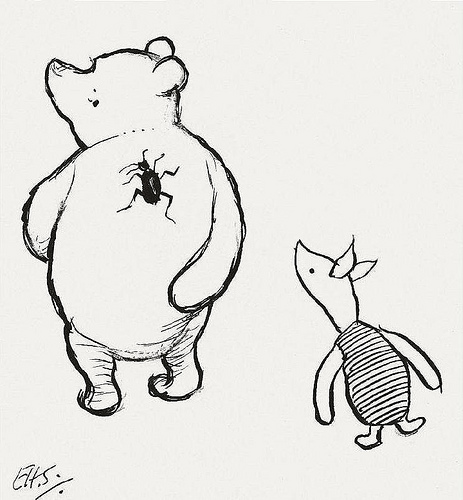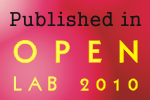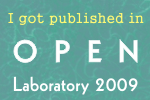The Search for Small finds Life on a Gradient
In Chapter 3 of The House at Pooh Corner, Rabbit organizes a search for Small, “One of my friends and relations.” Like a good manager (or scientist) Pooh lays out a program:
As soon as Rabbit was out of sight, Pooh remembered that he had forgotten to ask who Small was, and whether he was the sort of friend-and-relation who settled on one’s nose, or the sort who got trodden on by mistake, and as it was Too Late Now, he thought he would begin the Hunt by looking for Piglet, and asking him what they were looking for before he looked for it.
“And it’s no good looking at the Six Pine Trees for Piglet,” said Pooh to himself, “because he’s been organdized in a special place of his own. So I shall have to look for the Special Place first. I wonder where it is.”
And he wrote it down in his head like this:ORDER OF LOOKING FOR THINGS
- Special Place
- Piglet
- Small
- Rabbit
- Small again
(To find Piglet)
(To find who Small is)
(To find Small)
(To tell him I’ve found Small)
(To tell him I’ve found Rabbit)
“Which makes it look like a bothering sort of day,” thought Pooh as he stumped along.
Of course, it does turn out to be a bothering sort of day, and nothing goes according to plan. Pooh does find Small but that is almost an afterthought considering the other things he discovered that day.
Just like science. You set out looking for something, you find a bunch of other things. You may or may not find what you to originally set out to look for, but by the time you get to finding Small, finding him may not be the accomplishment you originally thought it may be. Something else has superseded it.
I started writing this post about the search for the smallest organism. Why? Because life in small packages fascinates me. How small can a biological package be, and still be considered living? Or: “The Search for Small(est)”.
But like Pooh, I bumbled along into other things.
So what is the smallest living thing? Starting at the smallest scale, viruses are considered by most scientists to be replicators, rather than organisms. They do not metabolize, and do not carry a full complement of reproduction machinery. They affect life profoundly, but they are missing a few essential components to actually be living. This view has been shaken up recently with the discovery of giant viruses that have genomes larger than some bacteria. These genomes are also quite complex, including coding for a large part of the reproductive machinery, having a selective membrane, and other of life’s goodies. Still, even if we consider giant viruses (or mimiviruses, as they are called) have crossed the border between non-life and life and are considered to be living, they are already not the smallest around. Not in genome size, and not in the particle size. Indeed, mimivirus were, for a long time, mistaken for bacteria due to their size, which is where they go their name: “mimi” is short for microbial mimic.
So: small bacteria? The bacterium Candidatus carsonella rudii is really small: its genome is just shy of 160,000 base pairs and it codes for about 182 predicted genes. But carsonella is an obligatory endosymbiont: it lives inside the cells of a special organ in the jumping plant louse or psyllid, an insect that feeds on plant phloem. Carsonella cannot survive outside its host and, in fact, its genome has lost so many genes that it is practically an organelle, not much larger than a mitochondrion. (A mitochondrion has 16,000 base-pairs and 32 genes.) Mitochondria are not living, although they originated from bacteria. Is carsonella there yet? Has it crossed into from life into non-life just as mimiviruses may have crossed from life into life? Buchnera, another insect endosymbiont is not much larger, with about 400 genes.
Mycoplasma genitalium is parasitic, but at least it codes for (almost) all of its proteins. It is usually heralded as “the smallest organism that can be grown in cell-free culture”. Its genome is 521 genes strong: just 3 times more than that of carsonella. It is not an obligatory endosymbiont, but it is a parasite: we can trick it to live and grow in a nutrient-rich soup, but in nature you will not find it outside a host.
Pelagibacter ubique, a marine bacterium, is, as far as we know, the smallest free-living organism, with approximately 1390 predicted genes.
So in searching for Small, I was asking a question that seemed to become more awkward each time I thought I found him: is this Small I found living or not? Each of the Smalls has certain characteristics of life, but where on the scale outlined by pelagibacter, mycoplasma, carsonella and a mitochondrion does life turn into non-life?
When a question you ask makes you feel weird, you may want to consider whether you are asking the right question. So maybe I was asking the wrong question. Maybe the definition of life is not a binary one and we should not think in terms of “living” and “not living”. Life may very well be a quantitative thing. Life sheds itself into non-life gradually, from free-living to parasitic to endiosymbiont to organelle. Indeed, self-replicating proteins (prions) and self-replicating RNA (viroids) are the byproduct of much more complex life, which has arisen before those replicators were derived. As they are, they are non-living, but they owe their existence to life.
So there is no single boundary where “life” crosses over to “non-life”. That’s not the right way to look at it. When journeying from virus through mimivirus, through organelle, various endosymbionts, parasites to free-living we are are simply hitting milestones on a continuum. Perhaps not that different from the continuum from which life emerged in the first place.
Understanding this probably beats actually finding Small.
Comments are closed.



















